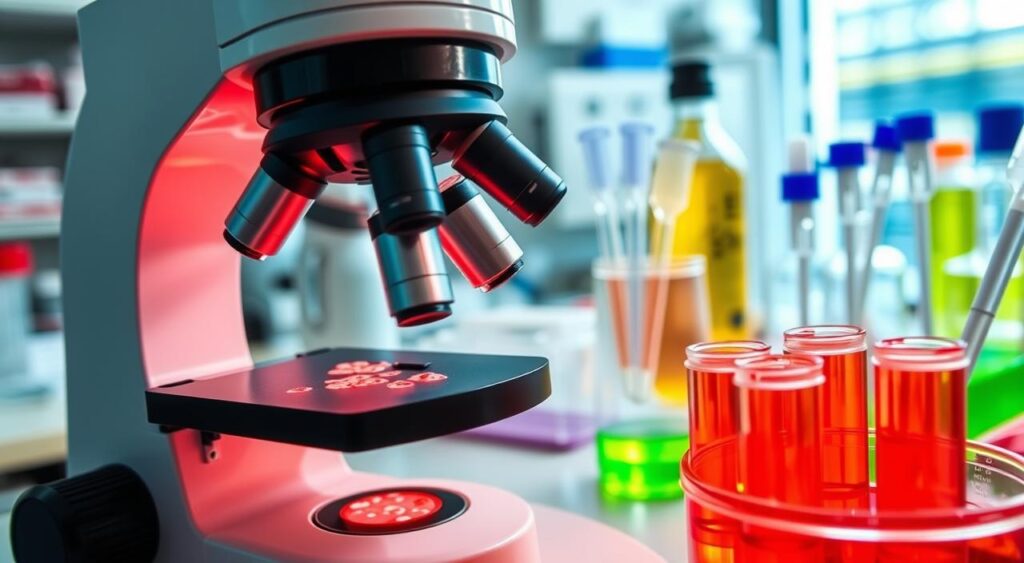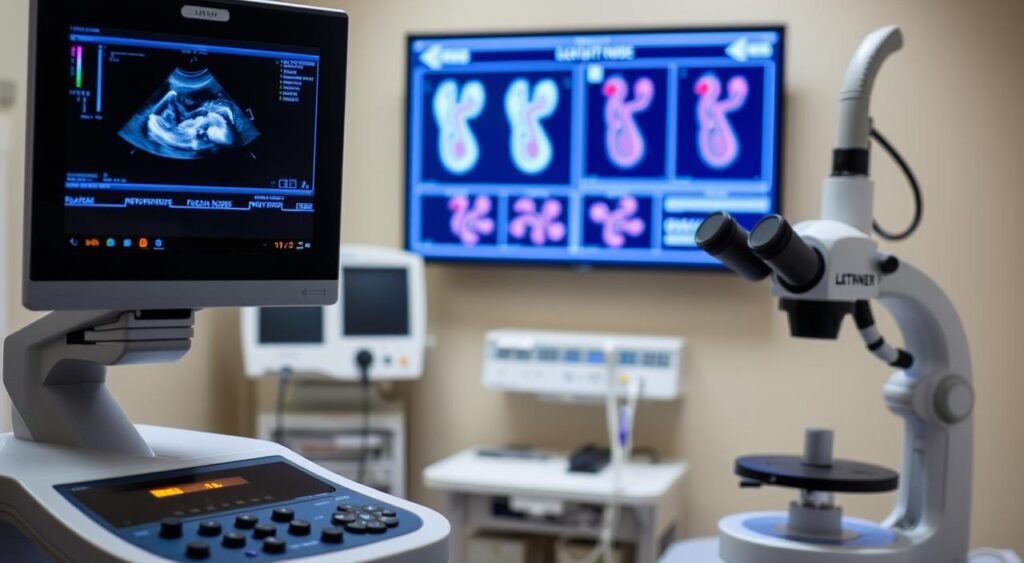Discover the key facts about lymphomas, including how they’re diagnosed and the most effective therapies. Arm yourself with the knowledge to navigate this condition.
Lymphomas, a type of lymph node cancer. Lymphomas affect the lymphatic system, which fights off infections and diseases. This system filters out harmful substances and cells, including cancer cells.

It’s important to know about lymphomas, including Hodgkin and non-Hodgkin lymphoma. Lymphoma is a complex disease that needs a detailed treatment plan. By understanding symptoms, diagnosis, and treatments, people can take charge of their health and make smart choices about their care.
Key Takeaways
- Lymphomas are a type of cancer that affects the lymphatic system
- There are two main types of lymphomas: Hodgkin lymphoma and non-Hodgkin lymphoma
- Understanding the symptoms, diagnosis, and treatment options for lymphomas is crucial for effective management and recovery
- Lymphomas can be treated with various options, including chemotherapy, radiation therapy, and immunotherapy
- Early diagnosis and treatment can significantly improve outcomes for individuals with lymphomas
- Lymph node cancer, such as lymphomas, requires a comprehensive approach to treatment
Understanding Lymphomas and Their Impact on Health
Lymphatic system cancer, also known as lymphatic cancer, affects the immune system. It happens when abnormal cells grow in the lymphatic system. This system helps protect the body from infections and diseases. Lymphomas can occur in various parts of the body, like lymph nodes, spleen, and bone marrow.
The symptoms of lymphomas depend on the type and where it is. Knowing how lymphomas affect health is key for good treatment plans. Symptoms include swelling, fatigue, and weight loss.
What Are Lymphomas?
Lymphomas are blood cancers that start in the lymphatic system. They are mainly two types: Hodgkin lymphoma and non-Hodgkin lymphoma. Hodgkin lymphoma has Reed-Sternberg cells, which are unique to this cancer.
How Lymphomas Affect the Body
Lymphomas can affect the body in different ways. Symptoms include fever, night sweats, and fatigue. They can also cause swelling and pain in affected areas. This cancer can make the body more prone to infections and diseases.
The Difference Between Hodgkin and Non-Hodgkin Lymphomas
Hodgkin lymphoma and non-Hodgkin lymphoma are different types of lymphatic cancer. Hodgkin lymphoma is usually more treatable and has a better outlook. Non-Hodgkin lymphoma is more common and can be aggressive. Knowing the differences is crucial for effective treatment and better patient outcomes.
Common Signs and Warning Signals
Lymphoma symptoms can be tricky to spot early. Common symptoms include swollen lymph nodes, fever, weight loss, and feeling very tired. It’s key to know these signs and see a doctor if they don’t go away or get worse.
Some common lymphoma symptoms to watch for include:
- Swollen lymph nodes in the neck, armpits, or groin
- Fever, which can be persistent or recurring
- Weight loss, which can be significant and unexplained
- Fatigue, which can be severe and affect daily activities
Spotting these symptoms early is vital for getting the right treatment. If you notice any of these, seeing a healthcare professional is a must.
Knowing these signs is the first step to taking care of your health. If you’re showing lymphoma symptoms, don’t hesitate to get medical help.
| Symptom | Description |
|---|---|
| Swollen lymph nodes | Enlarged lymph nodes in the neck, armpits, or groin |
| Fever | Persistent or recurring fever |
| Weight loss | Significant and unexplained weight loss |
| Fatigue | Severe and persistent fatigue |
Types of Lymphomas: A Comprehensive Overview
Lymphomas are cancers that affect the lymphatic system. They are mainly divided into hodgkin lymphoma and non-hodgkin lymphoma. Knowing the differences between these types is key to creating good treatment plans and better patient care.
Hodgkin Lymphoma Classifications
Hodgkin lymphoma is marked by Reed-Sternberg cells and makes up about 10% of lymphoma cases. It has several subtypes, such as:
- Nodular lymphocyte-predominant hodgkin lymphoma
- Classical hodgkin lymphoma
- Nodular sclerosis hodgkin lymphoma
Non-Hodgkin Lymphoma Variants
Non-hodgkin lymphoma, however, affects lymph nodes and doesn’t have Reed-Sternberg cells. Its subtypes include:
- Diffuse large B-cell lymphoma
- Follicular lymphoma
- Mantle cell lymphoma
| Lymphoma Type | Description |
|---|---|
| Hodgkin Lymphoma | Characterized by the presence of Reed-Sternberg cells |
| Non-Hodgkin Lymphoma | Characterized by the absence of Reed-Sternberg cells |
It’s vital to understand the different lymphomas, like hodgkin lymphoma and non-hodgkin lymphoma. This knowledge helps in making effective treatment plans and improving patient care.
The Diagnostic Journey
Getting a lymphoma diagnosis can change your life. It’s important to know about the steps to get this diagnosis. First, you’ll have a physical check-up and talk about your health history. Then, you might have imaging tests like CT scans and PET scans.
A biopsy might be needed to confirm the lymphoma diagnosis. This means taking a tissue sample from the affected area. It’s checked under a microscope for any abnormal cell growth. The journey to get a diagnosis can be long and include many tests. But, it’s key to finding the right treatment.

- Imaging tests such as CT scans and PET scans
- Biopsy
- Blood tests
Knowing about the diagnostic journey and the tests involved can make things less scary. It helps patients and their families feel more at ease.
Understanding Your Lymphoma Diagnosis
Getting a lymphoma diagnosis can feel overwhelming. But knowing what to expect can help ease the uncertainty. A lymphoma diagnosis comes after tests like blood work, imaging, and biopsies. These tests help figure out how far the disease has spread, which is key for treatment.
The staging process is crucial. It shows how big the tumor is and if it’s spread. This info helps create a treatment plan. Plans might include chemotherapy, radiation, or other treatments.
Staging Process
The staging process uses tests and procedures. These include:
- Imaging tests, such as CT scans or PET scans
- Blood tests, including complete blood counts and blood chemistry tests
- Biopsies, which involve removing a sample of tissue for examination
Diagnostic Tests and Procedures
More tests help confirm the diagnosis and track the disease. These include:
- Bone marrow biopsies
- Lymph node biopsies
- Imaging tests, such as MRI or ultrasound
Working with Your Healthcare Team
It’s important to work with a healthcare team. This team includes hematologists, oncologists, and radiologists. They create a treatment plan tailored to you. This plan might include chemotherapy, radiation, and immunotherapy.
| Treatment Option | Description |
|---|---|
| Chemotherapy | A type of treatment that uses drugs to kill cancer cells |
| Radiation Therapy | A type of treatment that uses high-energy rays to kill cancer cells |
| Immunotherapy | A type of treatment that uses the body’s immune system to fight cancer |
Treatment Options and Approaches
Lymphoma treatment varies based on the disease type and stage, and the patient’s health. Chemotherapy, radiation therapy, and immunotherapy are key treatments. Knowing these options helps patients and their families feel more at ease.
A treatment plan for lymphoma may include:
- Chemotherapy: using drugs to kill cancer cells
- Radiation therapy: using high-energy rays to kill cancer cells
- Immunotherapy: using the body’s immune system to fight cancer
It’s crucial to work with a healthcare team to find the best treatment for lymphoma.

Understanding the different treatments helps patients make informed decisions. This way, they can work towards the best outcome for their lymphoma treatment.
| Treatment Option | Description |
|---|---|
| Chemotherapy | Using drugs to kill cancer cells |
| Radiation Therapy | Using high-energy rays to kill cancer cells |
| Immunotherapy | Using the body’s immune system to fight cancer |
Living with Lymphomas: Management and Support
Getting a lymphoma diagnosis can feel overwhelming. But, with the right help and support, people can live better lives. It’s all about making lifestyle changes, building a support network, and finding ways to cope.
People with lymphoma should eat well and stay active. A healthy diet and regular exercise boost health and help with treatment. Eating lots of fruits, veggies, and whole grains is especially good for the immune system.
Support groups and online resources are also key. They offer emotional support, education, and a sense of community. These can help fight off feelings of loneliness and uncertainty.
Stress management and relaxation techniques are also important. Mindfulness, meditation, and yoga can help reduce stress. By using these methods, people with lymphoma can better handle their symptoms and feel happier.
By managing lymphoma in a holistic way, people can improve their lives. With the right support and strategies, they can face their journey with hope and confidence.
Prevention and Risk Factors
There’s no surefire way to stop lymph node cancer from happening. But knowing the risks and taking steps can lower your chance of getting lymphatic cancer. A weak immune system, being around certain chemicals and viruses, and having a family history of lymphoma are all risks.
Eating well and staying active can boost your health. This might lower your risk of getting lymph node cancer. Also, staying away from harmful chemicals and viruses, like the Epstein-Barr virus, can help.
Known Risk Factors
- Weakened immune system
- Exposure to certain chemicals and viruses
- Family history of lymphoma
Preventive Measures
There are steps you can take to lower your risk of lymph node cancer. Eating right, exercising, and avoiding harmful substances are good starts. These actions don’t guarantee you won’t get cancer, but they can help reduce your risk.
Conclusion: Navigating Your Lymphoma Journey
You’re not alone in your lymphoma journey. A dedicated healthcare team, reliable resources, and a strong support system can help. Understanding symptoms, diagnosis, and treatment options lets you make informed decisions and take charge of your health.
Prevention and knowing your risk factors are key. A healthy lifestyle and avoiding known risks can protect you. Use available resources and don’t hesitate to ask your healthcare providers for help.
Your lymphoma journey is unique, with its own twists and turns. But with a positive mindset, self-care, and teamwork with your medical team, you can overcome it. Remember, treatments are getting better, offering hope for the future.
Find your inner strength, surround yourself with support, and stay involved in your care. This way, you’ll move forward towards a healthier, more fulfilling life, no matter what challenges come your way.
FAQ
Q: What are lymphomas?
A: Lymphomas are cancers that affect the lymphatic system. This system helps fight infections and diseases. It includes lymph nodes, spleen, and bone marrow.
Q: What are the main types of lymphomas?
A: There are two main types: Hodgkin lymphoma and non-Hodgkin lymphoma. Hodgkin lymphoma has Reed-Sternberg cells. Non-Hodgkin lymphoma does not.
Q: What are the common symptoms of lymphomas?
A: Symptoms include swollen lymph nodes, fever, weight loss, and fatigue. These symptoms can be hard to spot early.
Q: How are lymphomas diagnosed?
A: Doctors use a physical exam, medical history, and imaging tests like CT scans. A biopsy is also needed to confirm the diagnosis.
Q: What are the treatment options for lymphomas?
A: Treatment depends on the disease type and stage, and the patient’s health. Options include chemotherapy, radiation, and immunotherapy.
Q: How can I manage the side effects of lymphoma treatment?
A: Eating well and exercising can help manage side effects. Support groups and counseling can also reduce anxiety and uncertainty.
Q: What are the risk factors for developing lymphomas?
A: Risk factors include a weak immune system, exposure to certain chemicals and viruses, and family history. While prevention is not guaranteed, knowing these factors can help reduce risk.
